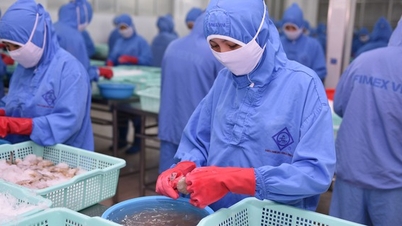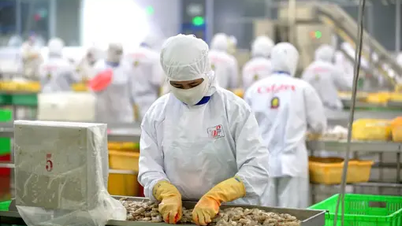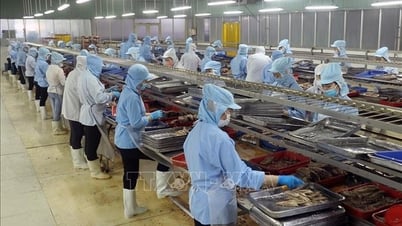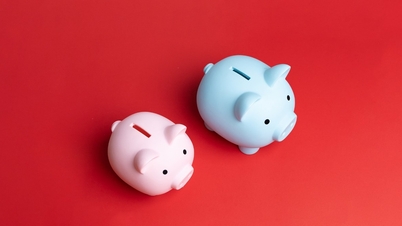 |
| Associate Professor, Dr. Vu Duy Vinh, Head of International Finance Department (Academy of Finance). |
According to the assessment of Associate Professor, Dr. Vu Duy Vinh, Head of the Faculty of International Finance (Academy of Finance), the 20% reciprocal tax that the United States imposes on imported goods from Vietnam may cause some difficulties for our country's export activities. However, on the contrary, the complete removal of tariffs on imported goods from the land of the Stars and Stripes also brings opportunities for Vietnam.
Why do you think that the US reciprocal tax also brings opportunities to Vietnam?
As we know, the US imposes a 20% tax rate on imported goods from Vietnam. But this is the general tax rate, and each group of goods will have a specific tax rate. The tax rate depends on many factors, the most important of which is whether the US has a trade deficit with that item or not.
Currently, Vietnam's trade deficit with the United States is mainly in computers, electronic products and components; machinery, equipment, tools, spare parts; cotton of all kinds; raw plastics; animal feed and raw materials; vegetables and fruits; chemical products, pharmaceuticals, wood and wood products; textile and footwear materials. The main items that Vietnam exports to the United States include computers, electronic products and components; machinery, equipment, tools and spare parts; textiles; footwear; agricultural and aquatic products; wooden furniture...
For key products that Vietnam exports to the United States that are in a trade deficit, such as computers, electronic products and components; machinery, equipment, tools, spare parts; vegetables and fruits (agricultural products), the highest tax rate (20%) may not be imposed. As for other key products such as textiles, footwear, agricultural products, aquatic products, and wooden products, Vietnam has a trade surplus, but in return, it has imported a deficit of raw materials to produce export goods such as cotton of all kinds; raw plastics; animal feed and raw materials; chemical products; raw wood; textile and footwear materials, so it may not be subject to too high a tax rate.
Thus, with a 20% (maximum) reciprocal tax rate, many Vietnamese commodity groups have an advantage because they enjoy lower tax rates, most likely lower than other direct competitors.
The US imposes a maximum tax rate of up to 20%, while Vietnam completely eliminates import taxes from the US. In your opinion, does this put Vietnam at a disadvantage?
In international trade relations, balancing the trade balance is the top priority. The trade balance is clearly tilted too much in Vietnam's favor, so we should not demand equality. Moreover, with the abolition of tariffs on imported goods from the United States, Vietnam also has its benefits.
The goods Vietnam imports from the United States are all goods that cannot be produced domestically, or the supply cannot meet the demand, so if we do not import from the United States, we will import from other countries. We mainly import these goods from countries that have signed free trade agreements with a 0% tax rate, so instead of importing from other countries, now we switch to importing from the United States with a 0% tax rate, Vietnam does not lose anything, if anything, it is the import tax on US goods. But in return, if the import turnover from the United States increases, the state budget will increase revenue through value added tax and special consumption tax (if any).
Furthermore, Vietnam imports from the United States mainly raw materials to produce goods for the domestic market such as cotton, fabric, plastic, animal feed, corn, soybeans (raw materials for animal feed), wood, chemicals, pharmaceuticals, textile raw materials for the textile, footwear, etc. When the tax rate is 0%, businesses can reduce input costs, reduce output prices and increase competitiveness in the export market.
Are Vietnamese consumers excited to buy duty-free goods from the United States, sir?
I think consumers prefer to use “Made in America” and European products over imported products of the same type from other countries. In fact, even when imported fruits from the US were not exempted from tax, Vietnam still had a trade deficit with this product from the US. Now that the tax is exempted, the import volume will certainly increase because the price is competitive compared to imported goods from other countries.
The elimination of tariffs on US goods certainly makes car enthusiasts the happiest. Vietnam has had an automobile manufacturing and assembly industry for decades, with many of the world's leading car manufacturers and brands such as Honda, Hyundai, Suzuki, Mitsubishi..., including car manufacturers from the US such as Chevrolet, Ford. However, every year, Vietnam still has to spend billions of dollars importing complete cars of the above brands, but mainly from Indonesia, Thailand and China.
According to the Customs Department ( Ministry of Finance ), in the first half of this year, Vietnam imported about 103,000 complete cars, an increase of more than 38% over the same period in 2024, including 78,345 passenger cars with less than 9 seats, an increase of 29.4%. The demand for imported cars is stable, cars from the United States are cheaper due to tax exemption, so the import of cars from this country is increased, instead of from the 3 markets mentioned above. Therefore, the state budget does not lose anything, domestic car manufacturing and assembling enterprises do not suffer any loss, because consumers prefer to use imported cars, so they do not buy domestic cars.
So does that mean that the reciprocal tax does not affect Vietnam's production, business, import and export activities?
Certainly, but we need to wait a little longer to see how the reciprocal tax will affect us. According to the General Statistics Office (Ministry of Finance), in the first 7 months of 2025, the total import-export turnover of goods reached 514.7 billion USD, an increase of 16.3%. Of which, exports increased by 14.8%; imports increased by nearly 18%. The United States continues to be Vietnam's largest export market and is still our country's largest trade surplus market.
The General Statistics Office's survey also showed that about 26.4% of enterprises confirmed that the number of export orders in the second quarter of 2025 was higher than in the first quarter of 2025, while only 22.2% of enterprises had a decrease in export orders. Export activities are still very bright, when in the third quarter of 2025, 30.8% of enterprises expected an increase in the number of export orders compared to the second quarter, while only 18.2% of enterprises expected a decrease in orders.
For now, the reciprocal tax has not had any impact. In the more distant future, if the US economy does not grow strongly, inflation increases, unemployment increases, then US consumers will certainly reduce spending, especially on non-essential goods, including imported goods from Vietnam. Therefore, businesses need to reduce production, transportation, logistics, and circulation costs to increase competitiveness, because when the US people tighten spending, direct competitors will find ways to reduce prices, then the purchasing power of Vietnamese goods in this market may decrease sharply.
Source: https://baodautu.vn/thue-doi-ung-cung-mang-la-cho-viet-nam-nhieu-co-hoi-d361880.html









































































































Comment (0)